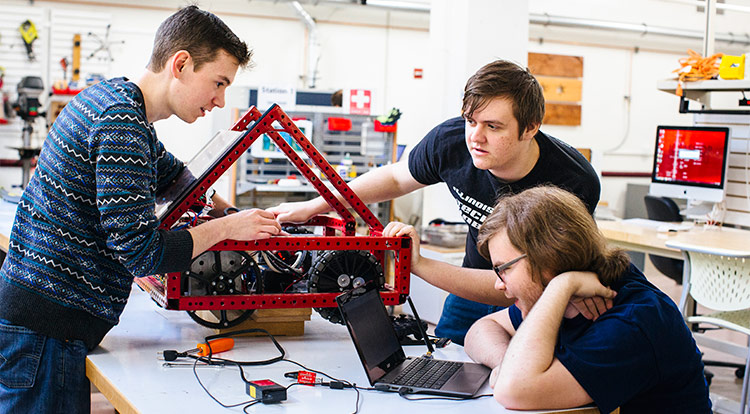
The I’s Have It
T
hrough her design of a custom-fit athletic shoe, Apoorva Shenoy (M.Des. ’18) says that she is “bringing back a more human way of running.” That Shenoy chooses to emphasize the human aspect of her startup idea is no surprise considering her educational pedigree: Illinois Tech’s Institute of Design (ID). Now housed in the Ed Kaplan Family Institute for Innovation and Tech Entrepreneurship, ID—founded as the New Bauhaus in 1937 under visionary László Moholy-Nagy—is recognized as a leading institution for its methods-based, human-centered approach to global challenges, inspiring students to place people first, and sometimes even feet first, as in the example of Shenoy.
Dissatisfied with a pair of running shoes that she purchased in summer 2017 from a well-known manufacturer, Shenoy went into design mode. She researched anatomy and biomechanics along with the athletic products market, shoe materials, and the relationships between individual running style, shoe fit, comfort, performance, and athletic goals. Her efforts gave rise to the personalized running shoe Solei.
“This project has been important to me because it takes a seemingly simple object driven by traditional industrial design; pulls it apart; and infuses it with rich design-thinking methodology, data, and technology to address user pain-points and needs” Shenoy explains. "It is also really exciting to work with the concept of 'data as an object' and how it can be applied to mass customization. There is so much novel work happening in this space.”
“I love working on real-life problems. You don’t get the chance too often in a classroom setting to help a nonprofit organization develop tools to reduce real fires affecting real people,”
—Tayseer Mozaffar
Solei begins with a personalized interview to understand a customer’s aspirations and athletic history before a 3-D form of the feet is obtained through digital methods. A specially made shoe sole and upper are then fashioned into a pair of running shoes. The Solei website, which debuted in late August, features a basic product that gives customers what they’re looking for while encouraging them to provide feedback for future development.
“Our launch strategy is to first approach people who absolutely need this product, such as runners who have anatomies that are not catered to. Once we have learned from this stage, we would like to launch via a crowdfunding platform. With this step, we hope to understand our users more, test the product on a smaller scale, and build brand value. We then hope to approach early-stage investors to take Solei to the next stage of growth,” says Shenoy, adding that friends and family provided funding for Solei’s early research and development.
Students using Illinois Tech’s Janet & Craig Duchossois Idea Shop, the Grainger Maker Space, and studios within the Kaplan Institute will be able to explore possibilities leading to new or improved products or services within shared and expanded work areas that lend themselves to collaboration.
“We heard from students that they want more open access to mock-ups and a way to do light prototyping, so there’s a whole second part of the Idea Shop that’s going to be open whenever the building is open that will allow students to do that,” says ID faculty member Jeremy Alexis (ARCH ’97, M.Des. ’99), director of both the Idea Shop and the university’s signature Interprofessional Projects (IPRO) Program, which will also be based out of the Kaplan Institute. “It’s really been designed around how we’ve observed students working. We still have a very safe and highly moderated area for the advanced machines, but we also have a lot more open room for students to work on and store projects and to build things.”

With its 3-D printers, CNC milling machines, laser cutters, and expansive setting, the Idea Shop, initially opened in 2010, has ignited the fire of creativity in students ranging from Dane Christianson (ME ’15), who designed and constructed his popular X-Cube twisty puzzle in the Idea Shop, to hackers who have participated in popular events hosted there such as the Solar Hack; the MonkeyBars Spring Build Hackathon; the Microsoft-Multi University Hackathon; and Code for the Kids, the Hackathon.
Alexis says that beginning with the fall 2018 semester, design thinking will be further expanded upon in IPRO courses on several levels.
“A curriculum designer has been working with us to roll out a revised version of our human-centered design approach coupled with agile project management to create a really distinctive IPRO way of working on challenges,” he says.
Tom Jacobius, IPRO director of operations, adds that other changes have been made from recommendations of the faculty committee.
“IPRO courses are now to be concentrated in two time slots during the week in order to best align student interests and majors with IPRO topics,” he says. “The new format will accommodate more of our research faculty in serving as technical experts across multiple IPRO teams in one setting within the expanses of the Kaplan Institute.”
One current IPRO course where this approach is continuing has the potential to provide an especially wide impact. Teams of students are working to improve preparedness and responsiveness to fire emergencies in Chicago through a collaboration with the American Red Cross (ARC) that provides access to its rich array of data through a grant from the Motorola Solutions Foundation. One of three instructors leading the ARC IPRO for the summer and fall sessions is predictive analytics expert Matt Robison.
“ARC gave us the data and encouraged our IPRO class to do what we wanted with it,” says Robison. He noted that student teams decided to focus their efforts on three project areas: examining the data to learn what general factors in a community make it more at-risk for a fire, learning what socioeconomic factors specifically contribute to the incidents of fire, and developing low-cost, high-effectiveness solutions to educate individuals in hot-zone neighborhoods where fire incidence is especially noted.
“It’s surprising how much work the students did and what they came up with. And the Kaplan Institute has been designed to inspire students to work on projects like this,” says Robison of the summer IPRO course, adding that faculty basically only set deadlines and provided feedback.
Tayseer Mozaffar (EMGT 4th year), whose team designed a fire risk self-assessment tool in the ARC course, says that it was very satisfying to know that this project is helping ARC reduce fires and alleviate human suffering.
“I love working on real-life problems. You don’t get the chance too often in a classroom setting to help a nonprofit organization develop tools to reduce real fires affecting real people,” Mozaffar explains. “I’m impressed by how much we did and am happy with what we accomplished. In my opinion, there’s no more valuable a class than an IPRO.”